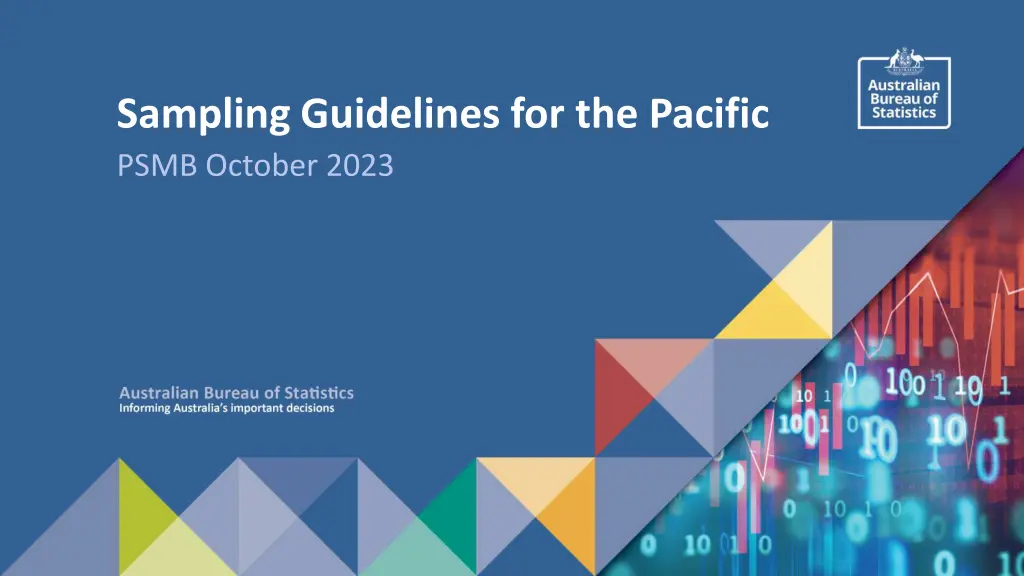
Guidelines for Effective Survey Sampling in the Pacific Region
Discover the comprehensive guidelines for survey sampling in the Pacific PSMB. Learn about the importance, accessibility, and living document approach for continuous improvement. Explore key concepts, theories, and practical applications tailored to the Pacific region.
Download Presentation

Please find below an Image/Link to download the presentation.
The content on the website is provided AS IS for your information and personal use only. It may not be sold, licensed, or shared on other websites without obtaining consent from the author. If you encounter any issues during the download, it is possible that the publisher has removed the file from their server.
You are allowed to download the files provided on this website for personal or commercial use, subject to the condition that they are used lawfully. All files are the property of their respective owners.
The content on the website is provided AS IS for your information and personal use only. It may not be sold, licensed, or shared on other websites without obtaining consent from the author.
E N D
Presentation Transcript
Sampling Guidelines for the Pacific PSMB October 2023
Why produce these Guidelines? Similar to documents available elsewhere, e.g. OECD, but aim to: Be accessible and not intimidating Take time to explain and walk the reader through Illustrate the ideas with diagrams and examples Tailored to the Pacific Can jump to the maths if looking for a formula Final document shaped by training materials used in SNZ, ABS and elsewhere 2 8/05/2025
We want a Living Document We want a document that is used and relevant, not one that sits on the shelf Can be expanded there is a chapter on Household Income and Expenditure Surveys and there could be other chapters on other specific survey types Focus on area-based sampling as most relevant to the Pacific but can be expanded to list-based sampling 3 8/05/2025
The first step Aim is to get something out that can be improved with time As it is used there will be more feedback very open to ongoing refinement 4 8/05/2025
Introduction to surveys and sampling Concepts and notation Survey quality (sampling and non-sampling error, variance and bias) Sampling frames Sample design 5 8/05/2025
Overview of sampling theory Simple Random sampling Systematic sampling Stratified sampling Multi-stage sampling Sample size calculations 6 8/05/2025
Household Income and Expenditure Surveys Basic design (stratified two-stage cluster design) First stage (preparing and selecting from an area frame) Second stage (listing and selecting households) Replacement procedures for areas and households Weights 7 8/05/2025
Appendices Case studies Computation of sample size Selection of a PPS sample Glossary Sampling methods for core and additional modules 8 8/05/2025
Sampling methods for core and additional modules (1) Issue: excessive HIES interview length and burden on respondents Many hours (hh size); 2 visits to complete the interview; etc. Low quality of answers, low willingness to participate. Current methodology: results significant at sub-national level (regions, urban/rural areas, etc.) all modules are filled by all households in all the selected EAs in each strata. 9 8/05/2025
Sampling methods for core and additional modules (2) Proposed methodology: Core modules , to be filled by all households, and Additional modules , provided to a sub- sample of respondents only results only significant at the National level (not at the level of each strata). Advantage: lower number of households receiving the additional modules: less time and resources needed by NSO Lower number of modules for each hh (A, B, C; D, E, F) Example: Climate Change module currently implemented in KIR (hhs with odd hh id; CAPI). 10 8/05/2025
Sampling methods for core and additional modules (3) How to identify a module as core or additional ? Proposal: modules contributing to income and expenditure aggregates and poverty monitoring are core ; the others are additional A country might promote an additional module (say: climate change) to core based on national priorities. Further reduction of interview time by extracting a sub- sample of household members (say: 1 member) responding to individual-level questions. Drawback: absence of the selected person (to be tested). 11 8/05/2025
PSMB is invited to: 1. Approve the Sampling Guidelines for the Pacific. 2. Note that SPC will publish the Sampling Guidelines as PSMB Guidance Note 3 and disseminate them to NSOs and partners across the Pacific. 3. Provide advice / guidance on further development of the guidelines and support needed to enable their implementation. 12 8/05/2025
